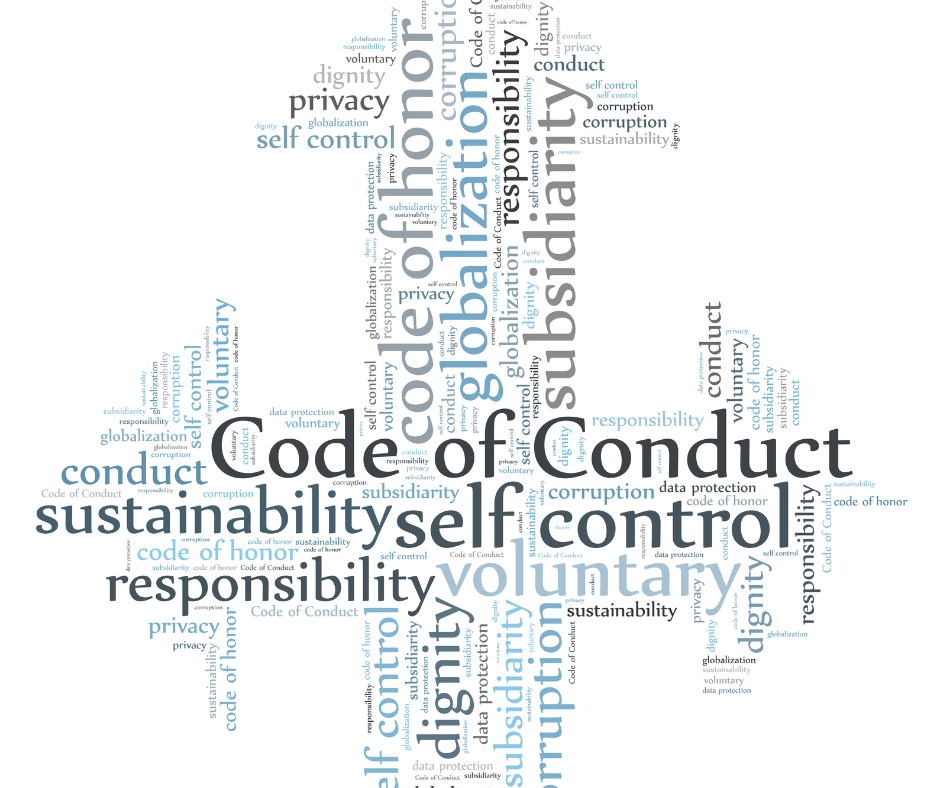
Implementing a “code of conduct in organization” can be the cornerstone of fostering a positive work environment, promoting ethical decision-making, and maintaining a strong reputation. However, creating an effective code of conduct can be a complex process that requires careful consideration of several factors. In this blog post, we will explore the importance of a code of conduct for both employees and organizations, how to build a comprehensive “code of conduct in organization”, and how to continuously improve it to ensure its effectiveness.
Key Takeaways
- A code of conduct is essential for organizations to promote ethical behaviour and improved performance.
- It provides numerous benefits to employees, such as a commitment to equal opportunity, health and safety policies and zero-tolerance policy for harassment or violence.
- Creating an effective code of conduct involves defining core values & principles, addressing employee behavior expectations & establishing guidelines for internal/external practices while implementing & enforcing it through training/communication with regular reviews/updates.
The Importance of a Code of Conduct in Organizations
Crafting a company’s code of conduct goes beyond mere formality; it molds the company culture and advocates ethical business conduct. A well-crafted code of conduct serves as a guiding light for employees when they face ethical dilemmas, helping them make informed decisions based on the organization’s values and principles. An effective code encourages employees to uphold the highest standards of professional conduct, which in turn boosts organizational performance and enhances the company’s reputation.
A clear and well-defined code of conduct offers considerable advantages to both employees and the organization. By implementing their own code, they can further explore the specific advantages an effective code of conduct presents for these two groups.
 Benefits for Employees
Benefits for Employees
Employees gain numerous benefits from a code of conduct, chiefly through clear guidelines and expectations fostering ethical behavior. Some of these benefits include:
- A commitment to equal opportunity can contribute to a positive company culture by pledging adherence to an accessible workplace and delineating what this entails for the organization.
- Health and safety policies help safeguard employees’ well-being, reflecting the company values.
- A strict zero-tolerance policy for harassment or violence ensures a secure and respectful work environment, an essential aspect of an organization’s code.
These benefits not only foster ethical business conduct but also contribute to employees’ overall job satisfaction and well-being. By understanding their responsibilities and the company’s core values, employees can confidently navigate their day-to-day operations and maintain positive relationships with their peers, supervisors, and business partners, all while upholding business ethics and protecting company assets. In doing so, the company stands as a model for ethical business conduct.
Advantages for the Organization
A code of conduct within an organization can yield extensive benefits, extending beyond employee satisfaction and ethical decision-making. A well-crafted code of conduct helps attract and retain top talent by offering a clear framework for employees to refer to in ambiguous situations, ultimately improving individual and organizational performance. Also, companies with strong ethical guidelines often enjoy enhanced public image, as demonstrated by Coca-Cola’s commitment to integrity, which bolsters their reputation.
To further reduce potential legal issues, organizations like Starbucks encourage employees to “Speak Up” and provide resources for them to raise concerns, adhering to the organization’s code. By actively promoting and enforcing a code of conduct, organizations can create a culture that values ethical practices, leading to increased productivity, reduced legal risks, and a strong reputation in their industry.
Code of Conduct Examples
Code of conduct examples provide valuable insights into the expected behavior and standards within a particular community, organization, or group. These examples outline specific guidelines and principles that members are encouraged to follow to maintain a respectful and inclusive environment. For instance, a code of conduct may emphasize the importance of respectful communication, collaboration, and understanding diverse perspectives. It often addresses issues such as harassment, discrimination, or other unacceptable behaviors and defines the consequences for violating these principles. By having clear code of conduct examples, communities can foster a culture of trust, accountability, and professionalism, ultimately ensuring a positive and harmonious experience for all participants.
Building a Comprehensive Code of Conduct

Constructing a comprehensive code of conduct requires an organization to think through several key elements such as core values and principles, employee behavior and expectations, and guidelines for internal and external practices. Each of these components plays a crucial role in ensuring that the code of conduct serves its intended purpose of guiding employees towards ethical practices and reinforcing the company’s values.
Customizing the company’s code of conduct to the specific requirements of the company and its sector is essential for promoting ethical practices relevant to the industry. Subsequent subsections delve into these elements in greater detail, offering insights into constructing a comprehensive and effective code of conduct.
Defining Core Values and Principles
Establishing core values and principles is the foundation of any code of conduct, as it helps organizations convey their ethical stance and sets the stage for the rest of the document. Common core values included in organizational codes of conduct are:
- Integrity
- Respect
- Accountability
- Excellence
- Collaboration
- Customer Focus
- Innovation
- Safety
These core values and principles should be tailored to the organization’s unique culture, mission, and vision, ensuring that they resonate with employees and guide them in their daily work. By clearly defining these values, the organization can create a strong ethical culture that serves as a compass for employees in their decision-making process and fosters a sense of pride and belonging within the company.
Addressing Employee Behavior and Expectations
A code of conduct should also address employee behavior and expectations, ensuring that staff understand their roles and responsibilities within the organization. This includes expectations for performance, interactions with business partners, and specific job duties. By providing clear guidelines on acceptable behaviors, the code of conduct can regulate and influence employee behavior in the workplace, fostering a congenial work atmosphere and promoting ethical practices.
Some behaviors that should be addressed in a code of conduct include:
- Respectful and professional behavior towards colleagues and clients
- Compliance with equal opportunity policies
- Proper use of company resources
- Adherence to confidentiality and data protection policies
- Prohibition of harassment or discrimination
- Ethical conduct in business dealings
Clearly outlining these expectations helps employees navigate their professional obligations and cultivate an atmosphere of openness and ethical judgment.
Establishing Guidelines for Internal and External Practices
In addition to addressing employee behavior and expectations, a code of conduct should also establish guidelines for internal practices and external business practices. Internal practices often form the foundation of a company’s operations, such as attendance and punctuality. External business practices, on the other hand, serve as a guidebook for how the company interacts with the external environment, including expectations for employees when interacting with external parties, such as maintaining confidentiality and demonstrating courtesy and respect to customers.
Establishing guidelines for internal and external practices enables employees to understand their professional obligations and make ethical decisions, thereby cultivating a more ethical company culture. By consistently reviewing and updating these guidelines, organizations can ensure that their code of conduct remains relevant and reflective of evolving cultural norms and industry standards.
Implementing and Enforcing the Code of Conduct

After formulating a comprehensive code of conduct, the subsequent step involves its implementation and enforcement within the organization. This process involves training and communication, as well as monitoring compliance and addressing any violations. Disseminating the code of conduct extensively throughout the organization is the initial step in its implementation.
Leadership plays a crucial role in the enforcement of the code of conduct by adhering to the expectations outlined in the document. Failure to abide by these expectations can compromise the code’s effectiveness and negatively impact employee morale.
Subsequent subsections will cover the significance of training and communication, along with monitoring compliance and managing violations.
Training and Communication
Effective training and communication are paramount in ensuring that employees comprehend the code of conduct and can implement it in their daily operations. The code of conduct should be communicated unambiguously and proficiently to all employees through training sessions, online modules, and periodic reminders.
Technology can play a significant role in facilitating the communication and training of a code of conduct within an organization. Online platforms, video conferencing tools, and e-learning courses can be employed to disseminate the code of conduct and provide engaging, interactive training to employees.
By using these methods, organizations can ensure that employees understand and apply the code of conduct in their daily work, promoting ethical behavior and social responsibility.
Monitoring Compliance and Handling Violations
Monitoring compliance and handling violations are essential aspects of enforcing a code of conduct. By observing compliance and addressing violations, organizations can maintain a culture of integrity and accountability. Procedures for dealing with breaches of a code of conduct typically involve:
- Documentation
- Notification
- Examination
- Determination
- Disciplinary measures
Organizations should also provide employees with a mechanism for reporting concerns and violations. Anonymous reporting can be an effective way to safeguard whistleblowers and afford employees the opportunity to report inappropriate or detrimental behavior. By promptly addressing all reports and providing the complainant with any necessary resources to address the incident or situation, organizations can further reinforce their commitment to ethical behavior and uphold the integrity of their code of conduct.
Companies Ethical Policies
Companies ethical policies play a critical role in shaping their organizational culture and public image. These policies encompass a set of guidelines and principles that dictate the behavior and decision-making processes within a company, ensuring that actions align with moral and societal standards. Ethical policies often cover areas such as fair treatment of employees, responsible sourcing and production, environmental sustainability, diversity and inclusion, and community engagement. By establishing clear ethical guidelines, companies demonstrate their commitment to social responsibility and accountability, fostering trust and confidence among stakeholders. Moreover, companies ethical policies provide a framework for employees to make ethical choices in their day-to-day operations, promoting a sense of responsibility and upholding the company’s values.
Learning from Successful Code of Conduct Examples

Examining successful examples of codes of conduct can yield valuable insights into innovative content and design approaches, facilitating the incorporation of effective practices within an organization. Successful code of conduct examples typically demonstrate tailored content that reflects the company’s culture, mission, values, and vision, along with clear communication of ethical principles and expectations from leadership.
Subsequent subsections delve into some innovative approaches to content and design, along with discussions on how organizations can adopt best practices from successful codes of conduct to formulate their own organization’s code.
Innovative Approaches to Content and Design
Innovative approaches to content and design involve methods used to make the code of conduct more engaging and user-friendly for employees. These approaches may include infographics, visuals, and other creative methods. By employing such techniques, organizations can speed up information processing, enhance engagement and comprehension, and deliver complex information in a visually appealing format.
Utilizing creative methods such as infographics and visuals can aid in creating a code of conduct that is both easy to read and understand, while simultaneously promoting ethical behavior and social responsibility. By learning from successful examples and incorporating innovative approaches, organizations can craft a code of conduct that effectively communicates their values and expectations to employees.
Adapting Best Practices to Your Organization
Adapting best practices from other organizations can assist in customizing the code of conduct to the specific needs and industry requirements of the organization. When adapting best practices for a specific industry, factors such as:
- Tone from the top
- Purpose and values orientation
- Applicability and administration
- Speaking up
- Risk topics
- Knowledge and training
- Ethical principles
should be taken into account.
Organizations like the ACM Code of Ethics and Professional Practice and the CFP Board have formulated case studies that provide practical guidance on implementing best practices for their codes of conduct. By adopting successful approaches utilized by other entities, organizations can construct a code of conduct that is suited to their individual requirements and sector regulations.
Continuously Improving Your Code of Conduct

Continuous refinement of the code of conduct is integral to maintaining its efficacy and relevance in an ever-changing business environment. This process involves regular reviews and updates, as well as measuring the impact of the code and adjusting strategies accordingly.
By evaluating the effect of the code of conduct, organizations can assess its significance, its efficacy in curtailing unethical behavior, and areas that may require improvement. Subsequent subsections will cover the significance of regular reviews and updates, along with measuring impact and adjusting strategies for continual improvement of the code.
Regular Reviews and Updates
Regular reviews and updates of the code of conduct are crucial in ensuring that it remains relevant and aligned with evolving legal regulations, cultural norms, and societal issues. It is recommended to review the code of conduct at least once a year to ensure that it remains compliant with any regulatory standards, guidance, company policies, laws, and industry standards that may have changed.
By consistently examining and modifying the code of conduct, organizations can guarantee that it remains pertinent and reflects the developing cultural norms and industry standards. This process also allows organizations to:
- Address any emerging ethical challenges or opportunities
- Ensure the code of conduct remains an effective tool for guiding employee behavior
- Promote a culture of integrity
Amazon Ethics Line
The Amazon Ethics Line serves as a crucial resource for employees and stakeholders alike, providing a platform for reporting ethical concerns within the organization. This confidential reporting mechanism encourages individuals to voice their worries about potential violations of ethical standards, misconduct, or breaches of company policies. Amazon places great emphasis on maintaining a culture of integrity and transparency, and the Ethics Line plays a vital role in upholding these principles. Employees are encouraged to utilize this tool to ensure ethical practices and compliance with both internal policies and external regulations. Amazon’s commitment to fostering a responsible and ethical environment is reflected in the accessibility and functionality of the Ethics Line, reinforcing the company’s dedication to accountability and ethical conduct throughout its operations.
Measuring Impact and Adjusting Strategies
Measuring the impact of the code of conduct and adjusting strategies based on the results can help organizations refine their approach and foster a more ethical company culture. Effective methods for determining the efficacy of a code of conduct within an organization include:
- Benchmarking and comparison
- Posing inquiries regarding ethics and organizational policy
- Monitoring employee behaviors
- Evaluating the code’s impact on reputation and relationships
By amending the code of conduct, altering the language, introducing fresh policies, or revising extant policies, organizations can optimize their code of conduct based on the results of their assessments. Utilizing the results to shape their training and communication initiatives and recognizing areas where further resources may be essential can further enhance the effectiveness of the code of conduct and promote a more ethical company culture.
Summary
In conclusion, a strong code of conduct is essential for fostering a positive work environment, promoting ethical decision-making, and maintaining a strong reputation within an organization. By building a comprehensive code of conduct, implementing and enforcing it effectively, learning from successful examples, and continuously improving it, organizations can create a culture that values ethical practices and empowers employees to make informed decisions based on the company’s values and principles. Ultimately, a well-crafted code of conduct serves as a guiding light for employees, helping them navigate the complex landscape of ethical dilemmas and promoting a culture of integrity and accountability.
Frequently Asked Questions
What are the 5 codes of conduct?
The five codes of conduct are Integrity, Objectivity, Professional competence and due care, Confidentiality, and Professional behaviour. These principles provide the framework for ethical practice and help ensure professionalism in the workplace.
What is code of conduct and ethics in organizations?
A Code of Conduct is a set of specific rules and regulations that employees must follow, as dictated by a Code of Ethics which outlines the organization’s principles and values. This code covers issues such as workplace behavior, dress code, and policies regarding conflicts of interest, confidentiality, and use of company resources.
What is the code of conduct in the professional workplace?
A code of conduct in the workplace is a set of rules outlining the values and principles that guide employee behavior, communication, respect, honesty, confidentiality, diversity and inclusion, and conflict resolution. It also includes guidelines about appropriate behavior for staff, disciplinary steps, and responsibilities while on the job.
What is a good code of conduct?
A good code of conduct should provide a clear statement of the company’s mission and values, as well as comprehensive workplace policies and procedures concerning employee behavior, harassment, conflicts of interest, and confidentiality.
What are the key components of a comprehensive code of conduct?
A comprehensive code of conduct should define core values and principles, address employee behavior and expectations, and establish guidelines for internal and external practices to ensure ethical and responsible conduct.